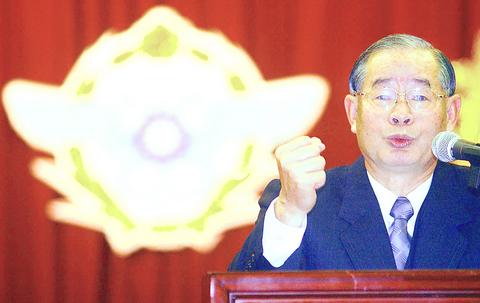Minister of National Defense Tang Yao-ming (
"Within 10 years, we expect to have the capabilities to effectively defend against China's ballistic missiles," Tang said.
Tang made the announcement yesterday at the first press conference he has called this year.

PHOTO: AFP
Tang did not go into detail about the missile defense system (MDS) that the military is developing.
But it was the first time that Tang made public a timetable for the development of the MDS, which had aroused much speculation from the press.
At the press conference, Tang talked about how the development of the MDS could counter China's development of ballistic missiles.
"Over the past one year, China has launched a total of 11 missile tests. It is actively developing missiles with a range of 6,000km, 8,000km, and 12,000km. The move clearly reflects China's ambitions," Tang said.
To counter missile threats from China, Tang said, "The military has set up a task force to plan for the establishment of a comprehensive missile defense system."
Tang refused to confirm whether the MDS will have anything to do with the theater missile defense system that the US plans to build in East Asia.
The development of MDS will be divided into three stages, defense sources said.
At the first stage, the military will build and deploy land-based missile interceptors and sensors (mainly radar) across the country.
The Patriot PAC-III missile defense system and a long-range radar are to be the key elements of the MDS at this stage.
The second stage will extend the deployment of missile interceptors and sensors to the sea.
The Kidd-class destroyers are to be the platform for the interceptors and sensors.
At the final stage, the military will seek to acquire airborne missile interceptors and sensors. This stage will be more difficult than the previous two.
The MDS, if built according to schedule, is expected to start operating within 10 years.
Costs for the MDS are estimated to be hundreds of billions of NT dollars, which would be a great financial burden to the military.
Vice commander-in-chief of the air force Lieutenant General Fu Wei-ku (
The cheaper option, Fu said, is to develop offensive capabilities similar to the ones China is employing against Taiwan.

Beijing could eventually see a full amphibious invasion of Taiwan as the only "prudent" way to bring about unification, the US Department of Defense said in a newly released annual report to Congress. The Pentagon's "Annual Report to Congress: Military and Security Developments Involving the People's Republic of China 2025," was in many ways similar to last year’s report but reorganized the analysis of the options China has to take over Taiwan. Generally, according to the report, Chinese leaders view the People's Liberation Army's (PLA) capabilities for a Taiwan campaign as improving, but they remain uncertain about its readiness to successfully seize

Taiwan is getting a day off on Christmas for the first time in 25 years. The change comes after opposition parties passed a law earlier this year to add or restore five public holidays, including Constitution Day, which falls on today, Dec. 25. The day marks the 1947 adoption of the constitution of the Republic of China, as the government in Taipei is formally known. Back then the Chinese Nationalist Party (KMT) governed China from Nanjing. When the KMT, now an opposition party in Taiwan, passed the legislation on holidays, it said that they would help “commemorate the history of national development.” That

Taiwan has overtaken South Korea this year in per capita income for the first time in 23 years, IMF data showed. Per capita income is a nation’s GDP divided by the total population, used to compare average wealth levels across countries. Taiwan also beat Japan this year on per capita income, after surpassing it for the first time last year, US magazine Newsweek reported yesterday. Across Asia, Taiwan ranked fourth for per capita income at US$37,827 this year due to sustained economic growth, the report said. In the top three spots were Singapore, Macau and Hong Kong, it said. South

HORROR STORIES: One victim recounted not realizing they had been stabbed and seeing people bleeding, while another recalled breaking down in tears after fleeing A man on Friday died after he tried to fight the knife-wielding suspect who went on a stabbing spree near two of Taipei’s busiest metro stations, Taipei Mayor Chiang Wan-an (蔣萬安) said. The 57-year-old man, identified by his family name, Yu (余), encountered the suspect at Exit M7 of Taipei Main Station and immediately tried to stop him, but was fatally wounded and later died, Chiang said, calling the incident “heartbreaking.” Yu’s family would receive at least NT$5 million (US$158,584) in compensation through the Taipei Rapid Transit Corp’s (TRTC) insurance coverage, he said after convening an emergency security response meeting yesterday morning. National